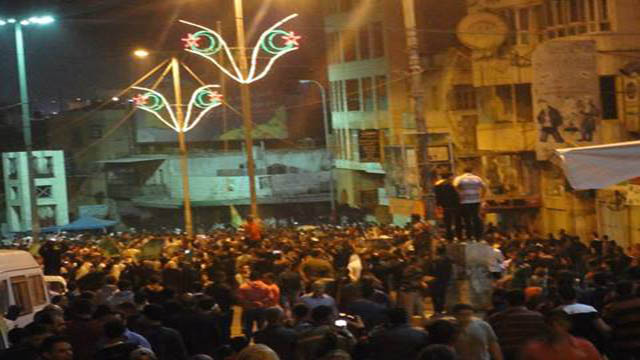Last night was not a normal night. Sources in Gaza reported that over one hundred Palestinians were martyred in a deadly massacre by Israeli forces in Gaza City’s al-Shajaiya neighborhood, with 300 more severely injured. This most recent bloody attack brings the total number of Palestinians killed in Operation Protective Edge to over 500, in addition to 3,000 wounded, since Israel began its offensive on Gaza a fortnight ago.
The international community has reacted with shock to the news of this most brutal attack; many world leaders, including UN chief Ban Ki-moon, stated that Israel must take much more care to avoid civilian deaths.
Naturally the reaction was strongest in the West Bank, where fellow Palestinians are standing in solidarity against the Israeli occupiers and oppressors. Feelings of grief, pain and anger permeated the streets and markets of Palestinian cities in the West Bank Sunday night, as thousands of Palestinians marched in protest.
Many of these demonstrations of solidarity led to serious clashes between incensed Palestinian youth and Israeli and Palestinian forces across the occupied Palestinian territory, which continued late into the night. In the Jalazoun refugee camp, north of Ramallah, young men shut down the camp’s main road and threw stones at soldiers. Israeli forces responded by trying to disperse the demonstrators with tear gas, before shooting live and rubber-coated ammunition into the crowds, which injured a reported eighteen young men. One unnamed man was shot in the head and his condition was described as serious.
The past few weeks have been marked by such confrontations between Palestinian protestors and security forces, occurring daily after Iftar, the breaking of the Ramadan fast. Many such clashes continue until the morning, such as in the Aroub refugee camp, situated near Beit Ummar, and in the troubled city of Hebron.
Last night, however, was not like the previous clashes. Following a press conference in Gaza, at which Hamas announced the alleged capture of an Israeli soldier, and the confirmation by Israel that eighteen soldiers had been killed in the offensive, celebrations hit the streets. Many Palestinian cities erupted in celebration of the news from Gaza, as well as other Arab capitals including the nearby Jordanian city of Amman. The capture of an Israeli soldier could be a major achievement for Hamas; it is a significant bargaining chip, potentially valuable in any negotiations, and which could perhaps secure the release of many Palestinian prisoners as happened in the October 2011 Gilad Shalit deal.
Some of these large ‘celebrations’ were party-like, involving few clashes with Israeli soldiers, but many led to even more aggressive and violent confrontations with forces in the area. Palestinian youth in Bethlehem, for example, marched under Hamas flags and slogans; in the ensuing clashes at the northern entrance to the city and in the nearby towns of al Khader and Tqoa, at least three young men were injured by live ammunition and rubber-coated bullets.
In other areas of the West Bank, equally vicious clashes took place, with dozens injured from various types of bullets and tear gas. In the town of Beit Ummar near Hebron, four were wounded by live and rubber – coated ammunition, and at the southern entrance of the town of Sair, fourteen were wounded, three of which are in critical condition.
In Ramallah, demonstrators in their thousands went to the Beit El checkpoint, northeast of the city, where clashes took place with Israeli soldiers, after Palestinian Authority police and security force failed to stop protesters from reaching the checkpoint.
In Jenin, Nablus, Tulkarem, Jericho and Qalqilya, thousands of others participated in the demonstrations. In Naim, east of Hebron, Ni’lin, west of Ramallah and in the East Jerusalem neighborhood of al-Issawiya, clashes also broke out.
Both national and Islamic parties announced that today would see a massive general strike all throughout the West Bank in protest of the massacre in Shujaiyya and in solidarity with Palestinians in the embattled Gaza Strip.
The feeling on the Palestinian street is that if the atrocities continue in Gaza, the West Bank might be pushed toward a Third Intifada.




